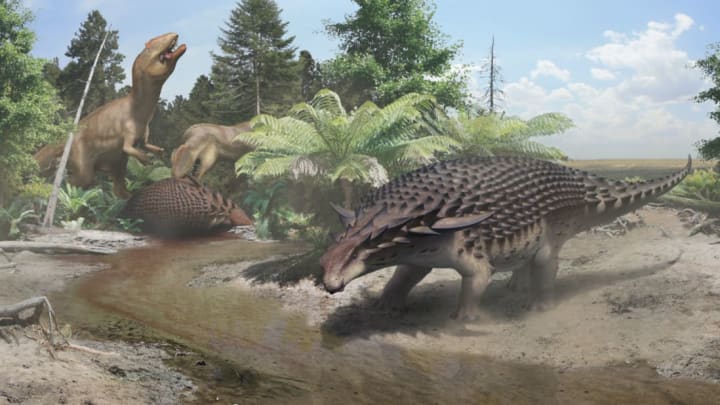The Exquisitely Preserved ‘Mona Lisa of Dinosaurs’ Has Been Named

Experts say the spectacularly well-preserved nodosaur now on display at Canada's Royal Tyrrell Museum (RTM) represents a new species—a hulking, armored beast that was not too proud to hide when predators were on the prowl. The research team described this "dinosaur equivalent of a tank" in the most recent issue of the journal Current Biology.
The nodosaur's massive remains were uncovered by miners in Alberta in 2011 in what was a seabed about 110 million years ago, when the creature died. The enormous block of stone and fossil was transferred to the museum, where technician Mark Mitchell set about freeing the specimen from its final resting place.
The task took Mitchell more than five years and 7000 hours. Every one of them was worth it: The results are breathtaking.
"This nodosaur is truly remarkable in that it is completely covered in preserved scaly skin, yet is also preserved in three dimensions, retaining the original shape of the animal. The result is that the animal looks almost the same today as it did back in the Early Cretaceous," museum scientist Caleb Brown said in a statement. "If you just squint your eyes a bit, you could almost believe it was sleeping. ... It will go down in science history as one of the most beautiful and best preserved dinosaur specimens—the Mona Lisa of dinosaurs."
While Mitchell chipped away at the stone tomb, Brown and his colleagues began trying to identify the animal inside. They knew it was a member of the stocky, heavily armored nodosaur family, but they couldn't figure out which one.
Eventually they realized why—it's not a species or genus anyone has ever seen before. Even so, the incredible quality of the museum's specimen made it possible for them to reconstruct what it might have looked like in life.
Chemical analysis of the nodosaur's scales and horn sheaths indicated the presence of a reddish-gold pigment called pheomelanin. In people, pheomelanin is what gives redheads their coppery locks and lends our lips and nipples their pinkish color. In nodosaurs, it probably turned them orange.
Some parts of them, at least. The researchers realized that their specimen, a herbivore, most likely had a pale belly, like a squirrel, and darker coloration on its back. This color patterning is called countershading. It's used to help animals blend into their surroundings and hide from predators.
That's right: Apparently the dinosaur's massive punk spikes and tough hide were not enough to keep it safe. It needed camouflage, too.
"Strong predation on a massive, heavily armored dinosaur illustrates just how dangerous the dinosaur predators of the Cretaceous must have been," Brown said.
The team named their new species Borealopelta markmitchelli. The genus name is a combination of "borealis" (Latin for "northern") and "pelta" (Greek for "shield'"). The species name is a tribute to Mitchell, the scientists write, for his "patient and skilled" revealing of their pride and joy.
All images courtesy of the Royal Tyrell Museum.